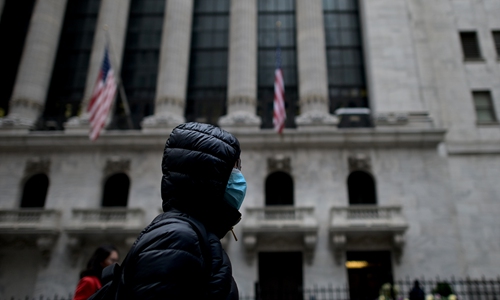HOME >> OPINION
When wearing a mask invites discrimination against immigrants in the West
By Rong Xiaoqing Source:Global Times Published: 2020/2/13 19:18:40

A woman with a facial mask passes the New York Stock Exchange on February 3, 2020 at Wall Street in New York City. Photo:AFP
Since the beginning of the novel coronavirus epidemic, Chinese living in the US and other Western countries have been facing a "to be or not to be" question. And the dilemma is now manifested in the wearing of surgical masks.
While people in China have been trying their best to secure a supply of masks they can wear when they head out into public places, overseas Chinese in other continents have been dealing with horror stories about mask-wearing people being verbally and even physically attacked by strangers.
In one such assault, videotaped by a passenger at a subway station in Manhattan's Chinatown, a mask-wearing woman was pummeled and kicked by a man. The witness told the media that the attacker called the woman a "diseased bitch." In another incident, a mask-wearing Chinese student was verbally and physically assaulted while she was walking on a street in Sheffield in the UK, according to local media there.
Making matters worse, any altercation shown on the internet that involved someone wearing a mask was quickly dubbed a "hate crime" by some netizens, even though it had nothing to do with the virus threat.
In New York, as the Department of Health has been telling people that they don't need to wear masks if they have not been exposed to the virus, rumors have been spreading that the Department of Education had issued a ban on wearing surgical masks at the city's schools. Such misinformation can quickly raise the fear levels.
These days overseas Chinese are debating whether they should wear a mask to avoid being infected by the virus, or not wear a mask to avoid discrimination. The debates are never conclusive but have caused greater confusion.
The brouhaha over mask wearing stems from a deeply rooted cultural difference. In a 2014 article entitled "A quick history of why Asians wear surgical masks in public" in Quartz, the author Jeff Yang described how mask wearing started in Japan in the early 20th century as protection against a flu epidemic, and ended up becoming part of mainstream culture. In the 21st century SARS, the bird flu and smog gave mask wearing new momentum. It has even become fashionable to wear designer masks in some East Asian countries in recent years.
Yang concluded his article with a prediction: "As pollution, climate change and pandemic illness become a routine aspect of our global reality, we may soon see facemask fashion go viral (excuse the pun) in Western countries as well."
The recent slew of conflicts shows that trend remains a long way off. In Western cultures wearing a mask still suggests sickness and risk, rather than a considerate precaution and even fashionable as many Asians believe.
What really confuses Chinese living in Western countries may not be the different implications that wearing a mask carries in their host countries and home countries. Rather it is the disparity between the freedom and rights they are promised and the discounted version that actually exist that triggers confusion and disappointment for immigrants.
For a long time, the word "assimilation" was celebrated as a barometer of success for immigrants. But what is rarely mentioned is the undercurrent of cultural dominance involved in this process.
In the early days, America's native people were forced to give up their own culture and send their children to English schools where they were given English names and be taught the invaders' culture, all in the name of assimilation. The strategy was a failure as it triggered fierce resistance and caused many social problems in the Native American community.
Nowadays, in the US, minorities are encouraged to preserve their own culture while they assimilate. Symbolic events like Black History Month (which is this month) and Asian Heritage Month (in May) are observed not only by people in the minority communities but by at least some parts of officialdom.
But this hasn't changed the fact that the concept of assimilation is based on the required acceptance of the dominance of one culture over all others. There is no other way for the minorities to really "melt in" to the mainstream except to alter themselves, or as a Chinese idiom goes to "chop off the toes to fit the shoes." This is a painful process even if it opens up some opportunities.
Of course, no one is forced at gunpoint to assimilate. By law everyone has the freedom and right to remain who they are. But in reality almost all the freedom and rights one is entitled to are based on this prerequisite, including the freedom and right to wear a protective mask.
The ideal of cultural equality in a multicultural society still looks like a mirage.
The author is a New York-based journalist and Alicia Patterson Foundation fellow. rong_xiaoqing@hotmail.com
Posted in: COLUMNISTS,VIEWPOINT